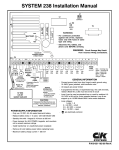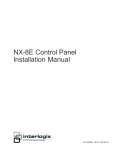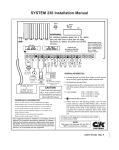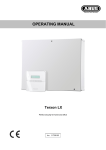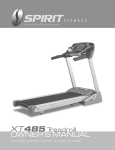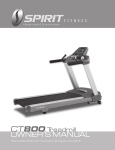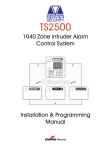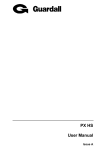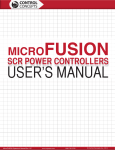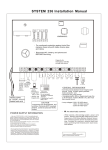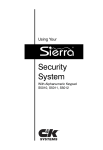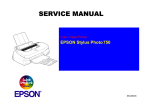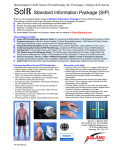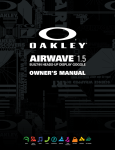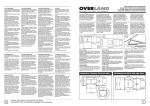Download System 236E Installation Instructions
Transcript
System 236E Installation Instructions Direct Conn Watch Dog DS1 JP2 WARNING: Disconnect AC, Battery, and Phone Cord BEFORE servicing. Use FCC compliant RJ-31X or RJ-38X Plug and Jack Red = Incoming Ring (R) Green = Incoming Tip (T) Gray = Seized Ring (R1) Brown = Seized Tip (T1) Blue = Tamper Orange = Tamper Bell Output not to exceed 600 mA Transformer GENERAL INFORMATION 16.5 VAC 25 - 40 VA 50 or 60 Hz Connect ground wire from door hinge to earth ground using 16 AWG, green/yellow jacketed, solid-conductor wire AUDIBLE 9.5 - 14 VDC All outputs are power limited If programmed for EOL or Supervised Loop, the 2.2K KEYPAD SWITCHED 9.8 - 14.0 VDC AUX POWER Do not exceed 3 keypads 9.3-14.0 VDC 12 VDC, 6.5 A-H or 12 VDC, 4.0 A-H Sealed Lead-Acid CAUTION: ohm EOL resistor must be at end of circuit Total Power from terminals BELL, AUX, and KEY+ NOT to exceed 800 mA, combined. All power outputs are current limited. (Also see NOTE: below.) POWER SUPPLY INFORMATION Use only 12 VDC, 6.5 A-H or 4.0 A-H sealed lead-acid battery Replace battery every 4 - 6 years with C&K Model 1265 or Model 1240 6.5 A-H standby battery time with 1 keypad is 24 hours at 150 mA 4.0 A-H standby battery time with 1 keypad is 7 hours at 400 mA Power demand for AUX POWER, keypads, and sounders not to exceed maximum ratings. Install transformer on unswitched power receptacle Maximum battery charge current = 350 mA This equipment should be installed in accordance with the National Fire Protection Association's Standard 72 Chapter 2 (National Fire Protection Association, Batterymarch Park, Quincy, MA 02269). Printed information describing proper installation, operation, testing maintenance, evacuation planning and repair service is to be provided with the equipment. Loop voltages: 0.0 - 1.5 VDC = short 1.6 - 3.1 VDC = normal 3.2 - 5.0 VDC = open are electrically common When used as a fire warning system, use a 4-wire smoke detector (Sentrol #ES-449C) with a Power Supervisory EOL Relay Module (System Sensor A77-716 Series) at the end of the detector power loop. Consider the maximum detector alarm load when confirming that the total alarm load is less than 800 mA. The control unit shall be checked by a qualified technician at least every 3 years. All ratings on this page are in compliance with UL 985, UL 1023, and UL 1635. NOTE: Total power from terminals AUX and KEY+ NOT to exceed 400 mA, combined. 5-051-504-00 Rev B System 236E Installation Instructions Table of Contents Subject System 236E Terminal Label FCC Notice Industry Canada UL Compliance Installation Earth Ground Wiring the Panel Standby Battery AC Power Audible Output Switched Auxiliary Power Arming Stations Addressing Keypads Loop Inputs Tamper Switch Installation Telephone Interface System Start-Up Factory Default Settings Programming Options (Alphabetical List) Programming the Panel Programming with the LED Keypad Programming with the Alpha Plus Keypad Programming the Alpha Plus Keypad Keypad Message Programming Programming Options (Numerical Order) Telephone Line Problems Watchdog Indicator Limitations of your alarm system Keypad Operation Command Summary Troubleshooting Reducing False Alarms Programming Worksheets FCC Rules Part 15: The REN is useful to determine the quantity of devices you may connect to your telephone line and still have all of those devices ring when your number is called. In most, but not all areas, the sum of the REN's of all devices should not exceed five (5.0). To be certain of the number of devices you may connect to your line, as determined by the REN, you should call your local telephone company to determine the maximum REN for your calling area. Page No. Front Cover 2 2 3 3 3 3-5 3 4 4 4 4 5 5 5-6 6 6 6-7 7 7 7-8 8 8 8-9 10 - 22 23 23 23 24 25 - 26 27 29 - 30 FCC Rules Part 68 (cont.) Should you experience trouble with the telephone lines, disconnect the equipment from the line to determine the source of the trouble. If it is determined that the equipment is malfunctioning, discontinue its use until the malfunction has been corrected. Any repairs or alterations made by the user of this equipment, or equipment malfunctions, may give the telephone company cause to request the user to disconnect the equipment. Repairs to this equipment should be made by an authorized agent of C&K Systems, Inc. Contact tour local alarm installation company for service. Should this equipment cause harm to the telephone network, the telephone company may temporarily discontinue your service. If possible, they will provide you with advance notice. Otherwise they will notify you as soon as possible. The telephone company will also advise you of changes in its facilities, equipment, operations, or procedures which could affect the operation of your equipment, allowing you the opportunity to maintain uninterrupted service. You will also be advised of your right to file a complaint with the FCC. This equipment must not be used on party lines or coin operated phone lines. Industry Canada Notice: The Industry Canada label identifies certain equipment. This certification means that the equipment meets certain telecommunications network protective, operational, and safety requirements as prescribed in the appropriate Terminal Equipment Technical Requirements documents. The Department does not guarantee the equipment will operate to the user's satisfaction. Before installing this equipment, users should ensure that it is permissible to be connected to the facilities of the local telecommunications company. The equipment must be installed using an acceptable method of connection. The customer should be aware that compliance with the above conditions may not prevent the degredation of service in some situations. Repairs to certified equipment should be coordinated by a representative designated by the supplier. Any repairs or alterations made by the user of this equipment, or equipment malfunctions may give the telecommunications company cause to request the user to disconnect the equipment. FCC Notice Users should ensure for their own protection that the electrical ground connections of the power utility, telephone lines, and internal metallic water pipe system, if present, are connected together. This precaution may be particularly important in rural areas. This equipment has been tested and found to comply with Part 15 of the FCC Rules. These limits are designed to provide reasonable protection against harmful interference in a residential installation. This equipment generates, uses, and can radiate radio frequency energy and, if not installed and used in accordance with the instructions, may cause harmful interference to radio communications. However, there is no guarantee that interference will not occur in a particular installation. If this equipment does cause harmful interference to radio or television reception, which can be determined by turning the equipment off and on, the user is encouraged to try to correct the interference by one or more of the following methods: Caution: Users should not attempt to make such connections themselves, but should contact the appropriate electric inspection authority, or electrician, as appropriate. Notice: The Ringer Equivalence Number (REN) assigned to each terminal device provides an indication of the maximum number of terminals allowed to be connected to a telephone interface. The termination on an interface may consist of any combination of devices subject only to the requirement that the sum of the Ringer Equivalence Numbers of all devices does not exceed 5. Reorient or relocate the receiving antenna, Connect the AC transformer to a different outlet so that the equipment and radio/ television are on different circuits; Relocate the equipment with respect to the radio/television; Consult the dealer or an experienced radio/TV technician for help. This Class B digital apparatus meets all requirements of the Canadian InterferenceCausing Equipement Regulations. Cet appareil numérique de la classe B respecte toutes les exigences du Règlement sur le matériel brouilleur du Canada. FCC Rules Part 68: This equipment complies with FCC Rules, Part 68. On the outside of this equipment is a label that contains, among other information, the FCC Registration Number and Ringer Equivalence Number (REN) for this equipment. If requested, provide this information to your telephone company. 2 System 236E Installation Instructions BEFORE YOU START INSTALLATION Scope of This Manual This manual contains basic installation and programming information for the System 236E control/communicator. For detailed information about remote programming, please refer to the Commander II/ Monitor II Operating Manual. Mounting The System 236E should be mounted in a location which allows convenient access to AC power, telephone connections, and earth ground. Remove the circuit board from the cabinet. This will prevent possible damage to the circuit board when removing the knock-outs. Accuracy This manual has been carefully checked for accuracy. However, C&K SYSTEMS assumes no liability for inaccuracies or actions resulting from the use of this manual. In addition, C&K reserves the right to modify the System 236E hardware, software, and manuals without prior notice. Remove the knock-outs. Mark the screw mounting holes on the wall. Mount the cabinet at the desired height and pass the cables through the knock-outs. UL COMPLIANCE Replace the circuit board, remembering to connect the ground lug to the lower left corner of the circuit board. The System 236E is in compliance with Underwriters Laboratories, Inc. Standards UL 985, Household Fire Warning System Units; UL 1023, Household Burglar Alarm System Units; and UL 1635, Digital Burglar Alarm Communicator System Units. The following programming restrictions must be observed to meet UL standards: 1. 2. 3. 4. 5. 6. 7. 8. 9. 10. 11. 12. 13. 14. 15. 16. Reconnect the spade lug to the lower door hinge. This provides the earth ground connection for the door. Earth Ground To ensure the effectiveness of the lightning and transient protection circuits, the control panel must be connected to "Earth Ground". Ideally, this should be a common ground to the power lines, telephone system, and security system. This type of ground, called a "Unified Earth Ground", provides the best protection. The ground connection, from a grounding rod, cold water pipe or other established ground point, is made to the green/yellow jacketed wire, providing a ground to the panel housing. The audible must be programmed to sound at least four minutes before silencing. No zone may be programmed for silent alarm. Fire zones must be programmed for 3 pulse temporal audible alarm. Burglar zones must be programmed for a steady audible. Burglar loops (non-24-hour loops) must be programmed for NO/NC. No Entry Delay may be greater than 45 seconds. No Exit Delay may be greater than 60 seconds. The Dynamic Battery Test must be enabled. The Unit Status Report must be enabled. The 24-hour Check-in must be enabled. No Delay Before Dial may be programmed for the communicator. The unit must not be programmed to dial a police station. Use screws (supplied) to secure cover or a lock must be installed on the cabinet. All devices must be UL listed. Loop Response Time must be set to 500mS. Telco connections must be made using 26 AWG (0.4 mm) or larger wire. Telephone Lines Power Lines Control Panel Power Line Earth Ground Unified Earth Ground with Bonded Ground Roots WIRING THE PANEL Zone Programming FIRE LOOP • • • • No Delay Before Dial • • Not shuntable 24-hour arming 3 Pulse temporal audible Supervised - latching for heat - resetting for smoke BURGLAR LOOP • • • • Telephone Earth Ground STANDBY BATTERY The System 236E is designed to operate using a 12 V, 6.5 A-H (Model 1265) or 12 V, 4.0 A-H (Model 1240) sealed lead-acid battery. Do not use non-rechargeable batteries or batteries other than sealed lead-acid. It is recommended that you replace the standby battery every four to six years. No Delay Before Dial Steady audible NO/NC with EOL 500mS Loop Response Time Install the battery with the terminals oriented toward the hinge side of the case and the battery mounted as close to the hinge as possible. Connect the red lead to the positive terminal of the battery and the black lead to the negative battery terminal. The panel is electronically protected against reverse battery polarity. 500mS Loop Response Time WARNING: Improper placement of the battery may result in ground trace shorting on the PCB. 3 System 236E Installation Instructions SWITCHED AUXILIARY POWER Terminal Label: AC AC POWER AC power is supplied from a 16.5 VAC, 25 - 40 VA transformer at 50 or 60 Hz. A UL listed Class 2 transformer must be used. Terminal Label: Aux & C The AUX(+) Terminal provides a positive 9.3 - 14.0 VDC for auxiliary devices that require switched power for resetting. Typical devices include glassbreak and smoke detectors. Connect the secondary of the transformer to the terminals labelled AC on the System 236E. Use at least 18 AWG (1.02 mm) wire to reduce voltage drops. The primary side of the transformer must be connected to an unswitched receptacle. Secure the transformer to the wall. The Terminal labelled C provides the power common. ARMING STATIONS AC Power Failure If an AC power failure lasts more than 15 minutes, the keypads will display a system trouble. An AC failure report will be sent, if programmed. When AC is restored for five minutes, a restoral report will be sent. Terminal Label: KEY+, C, & DATA The control panel connects to the alphanumeric or LED keypad with three data terminals. The hookup of the LED keypad is shown below and the Alphanumeric keypad connections are shown on the next page. Precautions DO NOT share the secondary of the transformer with other devices. A foreign ground can damage the power supply, voiding the warranty. Terminal Connections: DO NOT use any transformer other than that specified in the AC POWER section above. C (-) Terminal (black) is common. The common terminal is the power return and connects to the GND terminal on the keypad. DATA Terminal (green) is for keypad data. This terminal connects to the KDAT terminal on the keypad. KEY (+) Terminal (red) provides 9.8 - 14.0 VDC keypad power. This terminal connects to the Vs terminal on the keypad. Available Power The maximum total power available at the BELL(+), AUX(+), and KEY (+) terminals is 800 mA. The switched auxiliary and keypads share the same power bus. The combined power for the AUX(+) and KEY(+) terminals is 400 mA. Do not exceed 400 mA for all keypads and auxiliary devices. AUDIBLE OUTPUT The KEY(+) circuit is electronically protected against overload conditions by a self-resetting circuit. No user replaceable parts are used. Maximum wire length for connecting any keypad is 500' (152 m) of 22 AWG (0.643 mm) copper wire. Terminal Label: BELL & C The System 236E is capable of addressing up to seven Alpha and four LED keypads. Each LED keypad uses 40 mA of current. Eacj Alpha Plus keypad uses 64 mA of current. See Available Power for current limitations. The BELL(+) Terminal (Audible output) provides up to 600 mA at 9.5 - 14.0 VDC. For UL installations requiring supervision of the external bell, use the C&K Model 2350-SUP Bell Supervision Kit (P/N 0-000-231-11). Connecting the LED Keypad: The BELL(+) circuit is electronically protected against overload conditions by a self-resetting circuit. No user replaceable parts are used. Electromagnetic Interference Vibrating horns can produce electromagnetic interference (EMI). While EMI will not damage the System 236E, it can cause transmission errors and mis-dialing. To minimize EMI, install a 0.01 mfd, 100V capacitor across the terminals of the horn. The capacitor must be located in the horn. May not be loaded on all systems. Setting the Jumpers: W1 and W2 select the keypad address (see page 5 for addressing information). W3 installed W3 removed - 4 Entry/Exit Pre-Alert tones ACTIVE Entry Pre-Alert tone is ACTIVE, Exit Pre-Alert tone is INACTIVE. System 236E Installation Instructions Optional Connections: E1 and E2 are flying leads which are only installed if the Tamper Switch (SW1) is installed. Addressing Alpha Plus Keypads The Alpha Plus keypads use addresses 0 - 7. The first time you apply power to the system, any unaddressed Alpha Plus keypad will display KEYPAD ADDRESS?. Address each keyupad by pressing a number from 0 to 7 at the respective keypad. The exact number you press is not important, as long as each keypad has a different address. The keypad will not accept any address greater than 7. If you hsould accidentally use the same address for more than one keypad, the system will fail to properly respond to keypad input. Refer to page 26 for assistance in correcting this problem. ADDRESSING KEYPADS Each LED and Alphanumeric keypad installed in the system must have an address. Addresses must not be repeated. When replacing a keypad, make sure the replacement has the same address as the previous keypad. Once all keypads have been addressed, reset the panel by pressing [Master Combination] [*] [6] [8] [#] or by removing and restoring both AC and DC power. LOOP INPUTS Terminal Labels: Setting Address Jumpers The address on the LED keypad is selected by two jumpers (W1 and W2) on the printed circuit board. The chart below shows how to set Jumpers W1 and W2 to select the address for the LED keypads. Any address from 8 to 11 can be used. The exact number is not important, as long as each LED keypad in the system has a different address. In the event that two keypads are accidently given the same address, the system will fail to respond to keypad input. Refer to page 24 for assistance in correcting this problem. Z1-Z6&C W2 W1 W2 Installed Installed 8 Removed Installed 9 Installed Removed 10 Removed Removed 11 N.C. Alarm - Loops 1 - 6: 0.0 - 1.5 VDC = short 1.6 - 3.1 VDC = normal 3.2 - 5.0 VDC = open System 236E Loop Terminals W1 EOL Loop + System 236E Loop Terminals KEYPAD ADDRESS Connecting the Alpha Plus Keypad: + N.C. Trouble Supervised Loop N.O. Alarm - Each loop is individually configured through programming. Loops can be wired as EOL (with a 2.2K ohm end-ofline resistor) or as Supervised EOL. When programmed as EOL, either an open or a short will be reported as an alarm if the system is in an armed state. When programmed as Supervised EOL, an open will be reported as a Trouble, whether the system is armed or disarmed. A short on a Supervised EOL loop will be reported as an alarm if the system is armed, but will have no effect if the system is disarmed. Keyswitch Arming/Disarming The System 236E is capable of being armed or disarmed by installing a keyswitch on the Zone 6 input. Only a maintained switch may be used. The loop must be programmed for keyswitch arming (see CL 1D - 22, Digit Position 4). Keyswitch Arming reports as User #7. When Zone 6 is programmed for Keyswitch Arming, the only valid switch positions are: Open = System is Disarmed, and Closed = System is Armed. Use C & K Model Y101132V203NQ or equivalent switchlock. This configuration does not require an EOL resistor. Keyswitch arming follows all the rules of the panel's faulted arming type programming. Connect the alphanumeric keypad to the control panel as shown in the diagram above. The Alpha Plus keypad also has a jumper, located near the piezo, that must be installed when used with the System 236E control panel. TAMPER SWITCH INSTALLATION 1. Position the tamper switch inside the cabinet at the lower right corner of the cabinet. For the wall tamper, the plunger should go through the small hole in the back of the cabinet. For the door tamper, the plunger should face out from the cabinet. Refer to the drawing on page 6. 5 System 236E Installation Instructions SYSTEM TAMPER SWITCH INSTALLATION (cont.) 2. Connect the tamper switches in series and wire the tamper terminals to a dedicated zone of the control panel. 3. Program the dedicated zone as desired: EOL or Supervised EOL. START-UP Fifteen minutes after the panel is powered up, it will dynamically test the standby battery by interrupting AC power for two minutes and monitoring the battery under load. Once the tamper switches are installed, opening the cabinet door or removing the cabinet from the wall will result in a tamper signal at the panel. Standby Battery Time with One LED Keypad AUX POWER DRAIN* Tamper Switches installed in the System 236E cabinet 50 mA 70 mA 150 mA 300 mA 400 mA PRINTED CIRCUIT BOARD STANDBY TIME 6.5 A-H Battery 4.0 A-H Battery 32 hours 24 hours 14 hours 12 hours 24 hours 7 hours *Total power for all keypads and auxiliary If you replace the battery after a SYSTEM TROUBLE - LOW BATTERY message, you must re-test the battery under load conditions. Press [*] [6] [4] [#] to start the Dynamic Battery Test. TB1 Voltage Variations Output voltages may vary between 9 and 14.4 VDC (worst case), depending on the load and battery condition. DOOR TAMPER SWITCH LEAD-ACID BATTERY FACTORY DEFAULT SETTINGS WALL TAMPER SWITCH DEFAULT VALUES The default programming of the System 236E will allow you to use it as a local panel without any additional programming. The actual default programming values are shown on the Programming Worksheet (last 2 pages of this manual). TELEPHONE INTERFACE Use an FCC compliant RJ-31X or RJ-38X plug and jack to connect the System 236E to the phone line. The cord requires a modular connector on one end to plug into the wall outlet and flying leads on the other end to connect to the panel. Wire the modular phone connector as shown in the figure at the top of the next page. NOTE: If you connect power before wiring the loops, install a 2.2K EOL resistor across each loop. Combinations Installer combination: 0 1 2 3 4 5 User #1 (Master) combination: 1 2 3 4 User #2 - 6: disabled Default installer combination: yes Combination required: no Faulted Arming type: goof-proof Opening/closing: O/C reports enabled To connect the telephone system to the control panel, use the flying lead arrangement outlined below: RED = ring (R) BLUE and ORANGE = tamper GREEN = tip (T) YELLOW and BLACK = not used GRAY = ring seized (R1) Reporting Account #1: 000000 Dialing type: pulse RPS allowed: yes BROWN = tip seized (T1) T R T1 R1 1 R1 = Seized Ring 2 3 4 R1 Red RJ-38X Wiring Diagram Protector Ring Green T1 = Seized Tip T1 8 5 7 Zones Zone 1 = entry/exit delay, EOL circuit Zone 2 = interior, EOL circuit Zone 3 = doors or windows, EOL circuit Zone 4 = doors or windows, EOL circuit Zone 5 = doors or windows, EOL circuit Zone 6 = 24-hour, supervised Panic soft zone: steady audible, reporting to Receiver #1 only Incoming Telco Line Tip 6 Tamper Jumper Testing Test report interval: 7 days, disabled House Phones 6 System 236E Installation Instructions DEFAULT VALUES (cont.) Option Location Timing Entry time: 60 seconds, prewarn Exit time: 30 seconds, prewarn Bell time: 5 minutes Loop Restore Type Loop Shunting Enable Loop Shunt Report Code Low Battery Report Code Low Battery Restore Report Code Master Code Opening Report Code Opening/Closing Report Receiver Select Panic Audible Type Panic Report Code Panic Report Receiver Select Phone Ring Type Receiver #1 Message Format Receiver #1 Phone Number Receiver #1 Receive Format Receiver #2 Message Format Receiver #2 Phone Number Receiver #2 Receive Format RPS Enable RPS Phone Number Set Test Report Countdown Timer Test Report Code Test Report Interval Test Report Receiver Select Trouble Report Code Trouble Restore Code Unit Status Report Code User Arming Type User Combinations User Code Pager Enable Watchdog Reset Report Code 1D - 22 (3) 24 (1 - 6) 15 (2) 18 (5) 18 (6) 01 (1 - 4) 16 (2) 16 (1) 19 (4) 19 (1 - 2) 19 (3) 09 (5) 0A (2) 0C - 0E (1 - 6) 0A (1) 0A (4) 0F - 11 (1 - 6) 0A (3) 09 (3) 12 - 14 (1 - 6) A0 (1) 1A (1 - 2) 1A (4) 1A (3) 15 (4) 15 (5) 17 (1) 07 (1 - 6) 01 - 06 (1 - 4) 26 (1 - 6) 17 (2) Unit Control: Local system: yes Dynamic battery test: off PROGRAMMING OPTIONS The following is an alphabetical listing of all System 236E programming options, including Command Locations and Digit Positions. Digit Positions are inside parentheses ( ). Option AC Fail Report Code AC Line Frequency AC Restore Report Code Account Number Audible Time Autohome Enable Bell Fuse Fail Report Code Bell Fuse Restore Report Code Cancel Report Code Closing Report Code Combination Command Completed Programming Report Code Daily Battery Test Enable Default Installer Combination Delay Before Dial Enable Delay Before Dial Time Dial Attempts Dial Type Disable Instant/Home Exit Delay Disable Loop LEDs Door Chime Enable Duress Code Duress Report Code Entry Delay Time Event Report Receiver Select Exit Delay Time Failed To Communicate Report Code Faulted Arming Type Installer Combination Keypad Activated Pager Enable Keypad Pager Report Code Keypad RPS Enable Local System Only Loop Alarm Report Code Loop Arming Type Loop Audible Type Loop Circuit Type Loop Receiver Select Loop Response Time Loop Restore Reporting Code Location 18 (3) 08 (6) 18 (4) 0B (1 - 6) 1B (3) 1B (6) 18 (1) 18 (2) 15 (3) 16 (3) 08 (5) 17 (4) 08 (4) 08 (3) 25 (1 - 6) 1B (4) 09 (2) 09 (6) 1B (5) 08 (1) 23 (1 - 6) 28 (1 - 4) 16 (4 - 5) 1B (1) 15 (1) 1B (2) 17 (3) 08 (2) 00 (1 - 6) 27 (1) 27 (2 - 6) 09 (4) 09 (1) 1C (1 - 6) 1D - 22 (4) 1D - 22 (5) 1D - 22 (6) 1D - 22 (2) 1D - 22 (1) 15 (5) PROGRAMMING THE PANEL You can program the System 236E from the LED keypad or remotely using the Commander II software. This manual provides you with a brief description of each programming option beginning on page 8. Remote Programming information can be found in the Commander II/Monitor II Operating Manual. To Start Keypad Programming Key in the [Installer Combination][*][0][#]. The default installer combination is: 0 1 2 3 4 5. On the LED keypad, the ARM, SERVICE, and AC LED's will flash to indicate programming mode. Programming with the LED Keypad Programming with the LED keypad is a one-step process. Key in the two-digit address (Command Location) followed by the desired programming values (program data), then press the [#] key to store the data. The LED keypad does not display programmed values. If you are not sure that the correct programming values have been entered, program the Command Location again. 7 System 236E Installation Instructions System 236E LED Keypad Layout End of Programming Segment The last two Command Locations are CL 28 and CL A0. When you press the [#] key at these locations, the program will advance to CL 29 or CL A1. These locations are not used in the System 236E. If you enter CL 29 or CL A1, press [*][#] to exit programming, or press the Command Location followed by the [#] key for the desired programming location. ** To Exit Panel Programming When you have finished programming, press [*][#]. The panel will also exit the programming mode if you do not press any key within a five minute period. ** Keypad Activated Pager is only available on System 236E and later. NOTE: Command Location A0 must be addressed directly. To program Command Location A0 with an LED keypad, remember to enter the Command Location, followed by the program data, then press the [#] key. PROGRAMMING the ALPHA Plus KEYPAD In order to program the Alpha Plus keypad, you must have it wired to the SYSTEM 236E/236EC, have power applied to the panel, and have the keypad properly addressed. You can only program when the panel is disarmed. Warning: If you enter a Command Location and then press the [#] key without entering any data, the keypad will beep 5 times, indicating an error. To correct this problem, simply re-enter the Command Location and Data, then press the [#] key. NOTE: Programming the Keypad is NOT the same as Keypad Programming. (Keypad programming is used to program the control panel.) Programming with the Alpha Plus Keypad Entering program data with an Alpha keypad is a two-step process. First, key in the two-digit address (Command Location) to be programmed and press the [#] key. The Alpha keypad displays the CommandLocation and the data previously stored. Enter the new data you wish stored and press the [#] key to write the data. You can also scroll through the Command Locations in numerical order by alternately pressing and releasing the [#] key. The Alpha Keypad You can program the Alpha Plus keypads for special messages, each of the 6 zone labels, and the keypad address. Zone Labels display during the walk-test and when the [#] key is pressed during alarm memory or faults. The programmable Service Message is displayed during AC failure, fuse failure, communication failure, or low battery. The Dealer Message displays when the system is disarmed. The keypad address is initially displayed only during system start up (see page 5, Addressing Alpha Plus Keypads). NOTE: Command Location A0 must be addressed directly. When programming this Command Location with an Alpha keypad, the previously stored data is not displayed. To program this location, enter the Command Location followed by the [#] key. Then enter the data to be stored and again press the [#] key. These messages can be programmed directly from the Alpha keypad or remotely using the Commander II/Monitor II software package. For more detailed information about remote programming, refer to the Commander II/Monitor II Operating Manual. Programming Hexadecimal Numbers The Alpha keypad may be used to program the control panel. The cursor is moved to the right using the Emergency (E) key and to the left using the Police (P) key. The Fire (F) key enters a blank space and moves the cursor one position to the right. Keypad Message Programming The Alpha keypad programming template is used to allow the installer to program messages and zone descriptions into the Alpha keypads. The template shown below should be used when programming the keypad. Data is programmed into the panel using the hexadecimal number system, which consists of the digits 0 - 9 and the letters A - F. The digits 0 - 9 are entered directly from the keypad. The chart below shows how to enter the hexadecimal digits A through F. To activate the keypad programming mode, enter the [Installer's Code] [*] [0] [1] [#]. Information may be entered into the keypad in the form of letters (upper and lower case), numbers (0 9), and 22 special symbols. All characters are displayed in the order listed above, i.e. upper and lower case letters, numbers, and special symbols. The [Space] character precedes the letter A. PROGRAMMING CONVERSIONS Hexadecimal Value A B C D E F Key Strokes 0 1 2 3 4 5 The same procedure is used with both the LED and the Alpha keypads. 8 System 236E Installation Instructions To enter a Message or Label, use the [2] key to scroll through the characters until you reach the desired character. If you scroll past the desired character, the [8] key may be used to scroll backwards. When the desired character is displayed, press the [6] key to move the cursor to the next character position. The [4] key moves the cursor to the left. When all characters have been entered, press the [#] key to write the message and move to the next message position. Use the [0] key to move backward through the messages. ALPHA PLUS Programming Template The Scrolling order of the Alpha Plus messages is: SERVICE MESSAGE DEALER MESSAGE SOFT ZONE IDENTIFIER (A, B, and C) 1 2 3 4 5 6 7 8 9 0 HARDWIRED LOOP IDENTIFIERS KEYPAD ADDRESS For example, to change the Keypad Address: Enter Keypad programming, as described previously, then press [*] [BYPASS]. This will step backwards one step to Keypad Address. Enter the [New Address] followed by the [#] key. NOTE: If you do not press any key for 5 minutes, the keypad will automatically exit the programming mode. To Exit Keypad Programming When you have finished programming, press [*] [#]. The keypad will also exit the programming mode if you do not press any key within a five minute period. 9 CL 00 - 07 System 236E Installation Instructions Command Location 00: Installer Combination Default Values 0 1 2 3 4 5 0 0 (1) (2) (3) (4) (5) (6) Digit Positions (1) - (6): Installer Combination Combination must have 6 digits. Valid entries are 0 - 9. Command Locations 01 - 06: User Arming Combination (PIN) Default Values (User #1 shown) 01 = User #1 (Master) 02 = User #2 03 = User #3 1 2 3 4 0 1 04 = User #4 05 = User #5 06 = User #6 (1) (2) (3) (4) Digit Position (1) - (4): Arming Combination Combination must have 4 digits. Valid entries are 0 - 9. Master Combination can be used to change other combinations. To delete a PIN, enter 0 0 0 0. Command Location 07: User Opening/Closing Report Enable Default Values 0 0 0 0 0 0 0 7 NOTE: If sending Opening/Closing Reports to a Pager, CL 26 must also be programmed for reporting. (1) (2) (3) Digit Position (1): User #1 O/C Report Enable 0 = No Opening and No Closing Reports 1 = Opening and Closing Reports Digit Position (2): User #2 O/C Report Enable 0 = No Opening and No Closing Reports 1 = Opening and Closing Reports Digit Position (3): User #3 O/C Report Enable 0 = No Opening and No Closing Reports 1 = Opening and Closing Reports Digit Position (4): User #4 O/C Report Enable 0 = No Opening and No Closing Reports 1 = Opening and Closing Reports Digit Position (5): User #5 O/C Report Enable 0 = No Opening and No Closing Reports 1 = Opening and Closing Reports Digit Position (6): User #6 O/C Report Enable 0 = No Opening and No Closing Reports 1 = Opening and Closing Reports 10 (4) (5) (6) CL 08 and 09 System 236E Installation Instructions Command Location 08: Panel Control Options Default Values 0 0 1 0 0 1 0 8 (1) (2) (3) (4) (5) (6) Digit Position (1): Disable Loop LEDs 0 = No 1 = Yes: shuts zone LEDs off after 5 minutes Digit Position (2): Faulted Arming Type 0 = Goof-proof: zones must be normal or shunted to arm 1 = Force Arm: faulted zones will be shunted at end of Exit Delay Digit Position (3): Default Installer Combination 0 = No; this enables the Pirate-GuardTM feature for added security 1 = Yes; combination reverts to factory value on power loss Digit Position (4): Daily Battery Test Enable 0 = No 1 = Yes: tests battery under load every 4 hours Digit Position (5): Combination Command 0 = No 1 = Yes; requires combination for Bypass, Instant Arm, keypad-activated RPS, and Test (central station and bell) Digit Position (6): AC Line Frequency 0 = 50 Hz 1 = 60 Hz *Pirate Guard is a trademark of C&K Systems, Inc. Command Location 09: Telco Control Options Default Values 1 1 1 1 0 1 0 9 (1) (2) (3) Digit Position (1): Local System Only 0 = No 1 = Yes: disables all communications except RPS Digit Position (2): Dialing Attempts 0 = 4 attempts 1 = 8 attempts 2 = 14 attempts Digit Position (3): RPS Enable 0 = No 1 = Yes: allows remote programming to start from off-premise location Digit Position (4): Enable Keypad RPS 0 = No 1 = Yes: allows remote programming to start from on-site keypad command Digit Position (5): Phone Ring Type 0 = Single ring; uniformly timed rings with long pauses between rings 1 = Double ring; rings twice quickly followed by a long pause then rings twice again Digit Position (6): Dial Type 0 = Touch Tone* DTMF 1 = Pulse Dialing *Touch Tone is a trademark of AT&T 11 (4) (5) (6) CL 0A and 0B System 236E Installation Instructions Command Location 0A: Communications Format Default Values 1 1 1 1 0 A (1) (2) (3) (4) Digit Position (1): Receiver #1 Receiver Format 1 = Fast "A", 2300 Hz 2 = Slow "B", 1400 Hz 3 = SumCheck, 1400 Hz 6 = Ademco DTMF, 1400 Hz 7 = Pager 4 = SumCheck, 2300 Hz 5 = CFSK III Digit Position (2): Receiver #1 Message Format 1 = 3/1 Extended 2 = 4/2 (2-digit reporting code) 3 = CFSK III 4 = Pager Digit Position (3): Receiver #2 Receiver Format 1 = Fast "A", 2300 Hz 2 = Slow "B", 1400 Hz 3 = SumCheck, 1400 Hz 4 = SumCheck, 2300 Hz 5 = CFSK III 6 = Ademco DTMF, 1400 Hz 7 = Pager Digit Position (4): Receiver #2 Message Format 1 = 3/1 Extended 2 = 4/2 (2-digit reporting code) 3 = CFSK III 4 = Pager Valid combinations of Receiver Format and Message Format are listed below. Message Format 3/1 Extended Receiver Format All formats, except CFSK III and DTMF, 1400 Hz 4/2 (2-digit reporting) All formats, except CFSK III CFSK III CFSK III only Pager Pager only Command Location 0B: Account Number Default Values 0 0 0 0 0 0 0 B (1) (2) (3) (4) (5) (6) Digit Positions (1) - (6): Account Number Valid entries are 0 - F. The account number is right justified. The last digit must be in Position (6). The SYSTEM 236E will read the account number using: Digit Positions (4) - (6) in 3-digit accounts Digit Positions (3) - (6) in 4-digit accounts Digit Positions (1) - (6) in 6-digit accounts Fill all unused Digit Positions with 0's. PROGRAMMING CONVERSIONS Hexadecimal Value A B C D E F 12 Key Strokes 0 1 2 3 4 5 CL 0C - 0E System 236E Installation Instructions Command Locations 0C - 0E: Receiver #1 Phone Number Order in which the numbers will be dialed Command Location 0C (1) (2) (3) (4) (5) Command Location 0D (6) (1) (2) (3) (4) (5) Command Location 0E (6) (1) (2) (3) (4) (5) (6) Command Location 0C: Receiver #1 Phone Number (digits 1 - 6) Default Values E 0 0 0 0 0 0 C (1) (2) (3) (4) (5) (6) Digit Positions (1) - (6): Receiver #1 Phone Number (Digits 1 - 6) 0 - 9 = dialing digits 0 = dial tone detect (use if more than one dial tone must be detected) 2 = * (DTMF dialing only, not used in pulse dialing) 3 = # (DTMF dialing only, not used in pulse dialing) 4 = end of number (EON) 5 = 5 second delay Digit (1) is dialed first. You must place a 4 (EON) after the last digit to be dialed. Fill in remaining Positions with "0". Zeroes after EON will not be dialed. Command Location 0D: Receiver #1 Phone Number (digits 7 - 12) Default Values 0 0 0 0 0 0 0 D (1) (2) (3) (4) (5) (6) Command Location 0E: Receiver #1 Phone Number (digits 13 - 18) Default Values 0 0 0 0 0 0 0 E (1) (2) (3) (4) (5) (6) PROGRAMMING CONVERSIONS Hexadecimal Value A B C D E F 13 Key Strokes 0 1 2 3 4 5 CL 0F - 11 System 236E Installation Instructions Command Location 0F: Receiver #2 Phone Number (digits 1 - 6) Default Values E 0 0 0 0 0 0 F (1) (2) (3) (4) (5) (6) Digit Positions (1) - (6): Receiver #2 Phone Number (Digits 1 - 6) 0 - 9 = dialing digits 0 = dial tone detect (use if more than one dial tone must be detected) 2 = * (DTMF dialing only, not used in pulse dialing) 3 = # (DTMF dialing only, not used in pulse dialing) 4 = end of number (EON) 5 = 5 second delay Digit (1) is dialed first. You must place a 4 (EON) after the last digit to be dialed. Fill in remaining Positions with "0". Zeroes after EON will not be dialed. Command Location 10: Receiver #2 Phone Number (digits 7 - 12) Default Values 0 0 0 0 0 0 1 0 (1) (2) (3) (4) (5) (6) Command Location 11: Receiver #2 Phone Number (digits 13 - 18) Default Values 0 0 0 0 0 0 1 1 (1) (2) (3) (4) (5) (6) Command Location 12: RPS Phone Number (digits 1 - 6) Default Values E 0 0 0 0 0 1 2 (1) (2) (3) (4) (5) (6) For programming options (all locations), refer to Receiver #2 Phone Number above. Command Location 13: RPS Phone Number (digits 7 - 12) Default Values 0 0 0 0 0 0 1 3 (1) (2) (3) (4) (5) (6) Command Location 14: RPS Phone Number (digits 13 - 18) Default Values 0 0 0 0 0 0 1 4 (1) (2) (3) 14 (4) (5) (6) CL 15 and 16 System 236E Installation Instructions Command Location 15: Event Reports Default Values 1 9 D F E 1 5 (1) (2) (3) (4) (5) Digit Position (1): Event Report Receiver Select Shunts, All Restores, Status, Trouble, and Cancel 0 = Receiver 1 with Receiver 2 as back-up 1 = Receiver 1 only 2 = Receiver 2 only 3 = Receiver 1 and Receiver 2 (Dual Reporting) Digit Position (2): Loop Shunt Report Code Valid entries are 1 - F. This is a 1-digit reporting code used for all loops. For 2-digit reporting formats, the loop number will be automatically added as an extension. Programming a "0" in Position (2) disables shunt reporting for all loops. Digit Position (3): Cancel Report Code Valid entries are 1 - F. This is a 1-digit reporting code used for all loops. For 2-digit reporting formats, the User ID Number will be automatically added as an extension. Programming a "0" in Position (3) disables cancel reporting for all loops. Digit Position (4): Trouble Report Code Valid entries are 1 - F. This is a 1-digit reporting code used for all loops. For 2-digit reporting formats, the loop number will be automatically added as an extension. Programming a "0" in Position (4) disables trouble reporting for all loops. Digit Position (5): Loop Restore Reporting Code Restores are sent for alarm, shunt, and trouble. Valid entries are 1 - F. This is a 1-digit reporting code used for all loops. For 2-digit reporting formats, the loop number will be automatically added as an extension. Programming a "0" in Position (5) disables restore reporting for all loops. Command Location 16: Opening/Closing Reports Default Values 1 1 6 B C (1) (2) (3) 0 (4) (5) Digit Position (1): Opening/Closing Receiver Select 0 = Receiver 1 with Receiver 2 as back-up 1 = Receiver 1 only 2 = Receiver 2 only 3 = Receiver 1 and Receiver 2 (Dual Reporting) Digit Position (2): Opening Report Code Valid entries are 1 - F. Programming a "0" in Position (2) disables opening reports. This is a 1-digit reporting code. For 2-digit reporting formats, the User ID Number will be automatically added as an extension. Digit Position (3): Closing Report Code Valid entries are 1 - F. Programming a "0" in Position (2) disables opening reports. This is a 1-digit reporting code. For 2-digit reporting formats, the User ID Number will be automatically added as an extension. Digit Position (4 - 5): Duress Report Code Valid entries are 1 - F. Program "00" in these digits to disable Duress reporting. NOTE: When Duress is enabled, this report will use the same Report Routing as programmed for "Panic". See CL 19, Digit (3). 15 0 CL 17 and 18 System 236E Installation Instructions Command Location 17: Status Events Reporting Codes - #1 Default Values 0 0 0 0 1 7 (1) (2) (3) (4) Digit Position (1): Unit Status Report Code This is a global command for CL 17 and CL 18. If Position (1) is programmed with a "0", all Status Reports in CL 17 and CL 18 will be disabled. If Position (1) is programmed with any value other than 0, all Status Reports in CL 17 and CL 18 which have been enabled (not programmed with 0) will send reports. Status Reporting Codes will be a 2-digit code. The first digit is the contents of CL 17 (1) and the second digit is the Report Code programmed for the specific event. Digit Position (2): Watchdog Reset Report Code 0 = No 1 - F = Yes: this report code sent after each Watchdog reset Digit Position (3): Failed To Communicate Report Code 0 = No 1 - F = Yes: this report code sent after each failure to communicate Digit Position (4): Completed Programming Report Code 0 = No 1 - F = Yes: this report code sent on completion of panel programming Command Location 18: Status Events Reporting Codes - #2 Default Values 0 0 0 0 0 0 1 8 (1) (2) (3) (4) (5) (6) Digit Position (1): Bell Fuse Fail Report Code 0 = No 1 - F = Yes: this report code sent at Bell Fuse failure Digit Position (2): Bell Fuse Restore Report Code 0 = No 1 - F = Yes: this report code sent at Bell Fuse restoral Digit Position (3): AC Fail Report Code 0 = No 1 - F = Yes: this report code sent at AC failure Digit Position (4): AC Restore Report Code 0 = No 1 - F = Yes: this report code sent at AC restoral Digit Position (5): Low Battery Report Code 0 = No 1 - F = Yes: this report code sent at low battery voltage PROGRAMMING CONVERSIONS Hexadecimal Value Digit Position (6): Low Battery Restore Report Code 0 = No 1 - F = Yes: this report code sent when battery voltage returns to normal 16 A B C D E F Key Strokes 0 1 2 3 4 5 CL 19 and 1A System 236E Installation Instructions Command Location 19: Panic Report Default Values 0 0 1 1 1 9 (1) (2) (3) (4) Digit Positions (1) - (2): Panic Report Code Valid entries are 0 - F Program a "00" to disable Panic Reports. Digit Position (3): Panic Receiver Select 0 = Receiver 1 with Receiver 2 as back-up 1 = Receiver 1 only 2 = Receiver 2 only 3 = Receiver 1 and Receiver 2 (Dual Reporting) Digit Positions (4): Panic Audible Type 1 = 3 Pulse Temporal 2 = Pulsing 3 = Steady 4 = Chirp 5 = Silent with no LED 6 = Silent with LED Command Location 1A: Test Report Default Values 0 0 1 5 1 A (1) (2) (3) (4) Digit Positions (1) - (2): Test Report Code Valid entries are 0 - F Program a "00" to disable Test Reports. Digit Position (3): Test Report Receiver Select 0 = Receiver 1 with Receiver 2 as back-up 1 = Receiver 1 only 2 = Receiver 2 only 3 = Receiver 1 and Receiver 2 (Dual Reporting) Digit Position (4): Test Report Interval 0 = Manual (See NOTE) 1 = 1 hour 2 = 4 hours 3 = 12 hours 4 = 24 hours 5 = 7 days 6 = 14 days 7 = 30 days 8 = 1 hour, if armed 9 = 4 hours, if armed 0 = 12 hours, if armed 1 = 24 hours, if armed NOTE: When the Test Report Interval is programmed with a "0", automatic Test Reporting is disabled. To send a Manual Test Report to the Central Station, refer to the System Test procedures outlined in the Keypad End User Manual supplied with this System. PROGRAMMING CONVERSIONS Hexadecimal Value A B C D E F 17 Key Strokes 0 1 2 3 4 5 CL 1B and 1C System 236E Installation Instructions Command Location 1B: Panel Timing Default Values 2 3 2 1 0 0 1 B (1) (2) (3) (4) (5) (6) Digit Position (1): Entry Delay 1 = 10 seconds 2 = 30 seconds 3 = 60 seconds 4 = 90 seconds 5 = 120 seconds 6 = 150 seconds Digit Position (2): Exit Delay 1 = 10 seconds 2 = 30 seconds 3 = 60 seconds 4 = 90 seconds 5 = 120 seconds 6 = 150 seconds Digit Position (3): Audible Time 1 = 2 minutes 2 = 5 minutes 3 = 10 minutes 4 = 15 minutes 5 = 30 minutes Digit Position (4): Delay Before Dial Time 1 = 10 seconds 2 = 20 seconds 3 = 30 seconds 4 = 40 seconds 5 = 50 seconds 6 = 60 seconds Digit Position (5): Disable Instant/Home Exit Delay 0 = No 1 = Yes: no exit delay when system is Instant, Home, or Instant/Home armed Digit Position (6): Autohome Enable 0 = No 1 = Yes: interior zones automatically shunted when the system is armed and the exit door is not used Command Location 1C: Loop Alarm Reporting Codes Default Values 1 2 3 4 5 6 1 C (1) (2) (3) Digit Position (1): Loop 1 Alarm Report Code (4) (5) (6) Valid entries are 1 - F. Zone number is automatically added as the second digit. Program a "0" to disable Alarm Reports for this loop. Digit Position (2): Loop 2 Alarm Report Code See Digit Position (1) for programming information. Digit Position (3): Loop 3 Alarm Report Code See Digit Position (1) for programming information. Digit Position (4): Loop 4 Alarm Report Code See Digit Position (1) for programming information. Digit Position (5): Loop 5 Alarm Report Code PROGRAMMING CONVERSIONS See Digit Position (1) for programming information. Hexadecimal Value Digit Position (6): Loop 6 Alarm Report Code A B C D E F See Digit Position (1) for programming information. 18 Key Strokes 0 1 2 3 4 5 CL 1D - 23 System 236E Installation Instructions Command Locations 1D - 22: Loop Control 1D = Loop 1 1E = Loop 2 1F = Loop 3 20 = Loop 4 21 = Loop 5 22 = Loop 6 Default Values (Loop 1 defaults shown) 1 1 1 2 3 0 1 D Digit Position (1): Loop Response Time (1) (2) (3) (4) (5) (6) 0 = 10 milliseconds 1 = 500 milliseconds Digit Position (2): Loop Receiver Select 0 = Receiver 1 with Receiver 2 as back-up 1 = Receiver 1 only 2 = Receiver 2 only 3 = Receiver 1 and Receiver 2 (Dual Reporting) Digit Position (3): Loop Restore Type 0 = No restoral 1 = Return to normal 2 = Return to normal, bell silences 3 = Return to normal, system disarmed Digit Position (4): Loop Arming Type 0 = Instant 1 = Interior 2 = Delay 3 = Long Delay 4 = 24 hours (always armed) 5 = Keyswitch Arming (maintained)** ** Only available on Loop 6. Digit Position (1) must be programmed for 500 mSec with this option. Keyswitch Arming reports as User #7. Digit Position (5): Loop Audible Type 1 = 3 Pulse Temporal 2 = Pulsing 3 = Steady 4 = Chirp 5 = Silent with no LED 6 = Silent with LED Digit Position (6): Loop Circuit Type 7 = Ringback Enable * * Only available when Keyswitch Arming (Digit Position (4), Option 5) is active. Bell will sound once when arming and three times when disarming. 0 = EOL: alarm on open or short 1 = Supervised: trouble on open; alarm on short; follows bell time 2 = Supervised, bell latched: trouble on open; alarm on short; bell latched NOTE: A Loop programmed as type 1 or 2 will report any open as a Trouble condition, regardless of panel armed status. Command Location 23: Door Chime Enable Default Values 0 0 0 0 0 0 2 3 (1) (2) (3) Digit Position (1): Loop 1 Door Chime Enable 0 = No 1 = Yes: keypads beep two seconds when loop is faulted Digit Position (2): Loop 2 Door Chime Enable Refer to Digit Position (1) for programming options. Digit Position (3): Loop 3 Door Chime Enable Refer to Digit Position (1) for programming options. Digit Position (4): Loop 4 Door Chime Enable Refer to Digit Position (1) for programming options. Digit Position (5): Loop 5 Door Chime Enable Refer to Digit Position (1) for programming options. Digit Position (6): Loop 6 Door Chime Enable Refer to Digit Position (1) for programming options. 19 (4) (5) (6) CL 24 - 25 System 236E Installation Instructions Command Location 24: Shunting Enable Default Values 1 1 1 1 1 1 2 4 (1) (2) (3) (4) (5) (6) Digit Position (1): Loop 1 Shunting Enable 0 = No: makes this zone a priority zone (not shuntable) 1 = Yes: authorized users can bypass or force arm Digit Position (2): Loop 2 Shunting Enable Refer to Digit Position (1) for programming options. Digit Position (3): Loop 3 Shunting Enable Refer to Digit Position (1) for programming options. Digit Position (4): Loop 4 Shunting Enable Refer to Digit Position (1) for programming options. Digit Position (5): Loop 5 Shunting Enable Refer to Digit Position (1) for programming options. Digit Position (6): Loop 6 Shunting Enable Refer to Digit Position (1) for programming options. Command Location 25: Delay Before Dial Enable Default Values 0 0 0 0 0 0 2 5 (1) (2) (3) Digit Position (1): Loop 1 Delay Before Dial Enable 0 = No 1 = Yes: this loop will delay dialing on alarm for time programmed in CL 1B (4) Digit Position (2): Loop 2 Delay Before Dial Enable Refer to Digit Position (1) for programming options. Digit Position (3): Loop 3 Delay Before Dial Enable Refer to Digit Position (1) for programming options. Digit Position (4): Loop 4 Delay Before Dial Enable Refer to Digit Position (1) for programming options. Digit Position (5): Loop 5 Delay Before Dial Enable Refer to Digit Position (1) for programming options. Digit Position (6): Loop 6 Delay Before Dial Enable Refer to Digit Position (1) for programming options. 20 (4) (5) (6) CL 26 - 27 System 236E Installation Instructions Command Location 26: User Code Pager Enable Default Values 0 NOTE: If sending Opening/Closing Reports to a Pager, CL 07 must also be programmed for reporting and CL 16, Digits 2 & 3 must each be programmed to a different non-zero value. 0 0 0 0 0 2 6 (1) (2) (3) (4) (5) (6) Digit Position (1): User Code 1 0 = No: Pager reporting is not active with this User Code. 1 = Yes: Pager reporting is active in association with the User Code. If the User Code is used to Arm the system, the pager code sent is "9" with the User Number as the second digit. If the User Code is used to Disarm the system, the pager code sent is "8" with the User Number as the second digit. Digit Position (2): User Code 2 Refer to Digit Position (1) for programming options. Digit Position (3): User Code 3 Refer to Digit Position (1) for programming options. Digit Position (4): User Code 4 Refer to Digit Position (1) for programming options. Digit Position (5): User Code 5 Refer to Digit Position (1) for programming options. Digit Position (6): User Code 6 Refer to Digit Position (1) for programming options. Command Location 27: Keypad Activated Pager Default Values 0 E 0 0 0 0 2 7 (1) (2) (3) Digit Position (1): Enable Keypad Pager 0 = No 1 = Yes: Pressing the [*] and [#] keys simultaneously will send the message programmed into Digit Positions (2 - 6) to the pager. Pager Receiver and Message format are defined in CL 0A. (Available on System 236E LED Keypad only.) Digit Position (2 - 6): Keypad Pager Report Code Valid entries are 0 - 9. Codes may vary from 1 to 5 digits in length. To enter a code of less than 5 digits, follow the last digit with "E" (*4) and fill remaining digits with "0". The "E" and any additional digits will not be sent. 21 (4) (5) (6) CL 28 and A0 System 236E Installation Instructions Command Location 28: Duress Code Default Values 0 0 0 0 2 8 (1) (2) (3) (4) Digit Position (1 - 4): Duress Code This 4-digit code is active only if the system is armed. Entering the Duress Code will disarm the system while sending a Duress Report to the Central Station. Duress Reports are sent as User #8. Report Routing will be the same as that specified for Panic Reports (CL 19 Digit Position 3). NOTE: The Duress Code is Installer programmable only. Command Location A0: Test Report Countdown Timer A 0 (1) Digit Position (1): Set Test Report Countdown Timer This command sets the time when the first Test Report is transmitted to the central station. The System 236E will use this transmission time whenever it is powered up or the CPU is reset (unless CL A0 is reprogrammed). 0 = 1/4 hour 1 = 1/2 hour 2 = 1 hour 3 = 2 hours 4 = 3 hours 5 = 4 hours 6 = 6 hours 7 = 8 hours 8 = 10 hours 9 = 24 hours 0 = 14 hours 1 = 16 hours 2 = 18 hours 3 = 20 hours 4 = 22 hours 5 = 24 hours Example: The time is 1500 hours (3:00 pm). You want the first Test Report to transmit at 0100 hours (1:00 am). 3:00 pm + 10 hours = 1:00 am. Program the value "8" in Position (1) of CL A0. 22 System 236E Installation Instructions TESTING Once the installation is complete, connect AC and DC power. Complete programming, if required. Test all panel operations. TO THE INSTALLER Regular maintenance and inspection (at least monthly) by the installer, and frequent testing by the user, are vital to the continuous and satisfying operation of any alarm system. The installer should assume the responsibility for developing and offering a regular maintenance program to the user, as well as acquainting the user with the proper operation and limitations of the alarm system and its component parts. Telephone Line Problems (cont.) If the phone does not work correctly after the control panel has been disconnected from the phone line, notify the telephone company and request prompt repair. The user may not under any circumstances, in or out of warranty, attempt any service or repairs on the System 236E. The control panel must be returned to C&K SYSTEMS or an authorized service agency for repairs. WATCHDOG INDICATOR DS1 Recommendations must include a specific program of regular testing (at least weekly) to insure that the system is operating properly. WATCH DOG TELEPHONE LINE PROBLEMS In the event of telephone line problems, disconnect the System 236E by removing the modular connector plug from the telco interface jack. Do not disconnect the connection inside the System 236E cabinet. Doing so will prevent the premise phones from operating. If the phone works correctly after the control panel has been disconnected from the phone line, the control panel has a problem and should be returned for repair. The System 236E is protected by an advanced circuit that constantly monitors the microprocessor. As long as the panel is powered and operating normally, the DS1 LED on the circuit board will flash. If the Watchdog circuit detects a failure, it will attempt to reset the panel. If the panel resumes normal operations after a Watchdog reset, the DS1 LED will resume its normal flashing. No further action is required. If the panel does not operate properly after a Watchdog reset, call the C&K Technical Support Hotline at 1-800-227-8065. THE LIMITATIONS OF YOUR ALARM SYSTEM While the System 236E is an advanced design security system, it does not offer guaranteed protection against burglary, fire, or other losses. Any alarm system, whether commercial or residential, is subject to compromise or failure-to-warn for a variety of reasons. These include: Intruders may gain access through unprotected openings or have the technical sophistication to bypass an alarm sensor or disconnect an alarm warning device. Intrusion detectors, smoke detectors, and many sensing devices will not operate without power. Devices powered by AC will not work if their AC power supply is off for any reason and their backup batteries are missing, dead, or improperly installed. . . . . . Alarm warning devices such as sirens, bells, and horns may not alert people or wake up sleepers if they are located on the other side of closed or partly closed doors. If warning devices are on a different level of the residence from bedrooms, they are less likely to waken or alert people inside the bedrooms. Telephone lines needed to transmit alarm signals from a premise to a central monitoring station may be out of service or temporarily out of service. Telephone lines are subject to compromise by sophisticated methods of attack. 23 . . Smoke detectors used in conjunction with the alarm system may not sense fires that start where smoke cannot reach the detectors, such as chimneys, walls, or roofs, or on the other side of closed doors. Smoke detectors also may not sense a fire on another level of the residence or building. A second-floor detector, for example, may not sense a first-floor or basement fire. Finally, smoke detectors have sensing limitations. No smoke detector can sense every kind of fire every time. In general, detectors may not always warn you about fires caused by carelessness and safety hazards, like smoking in bed, violent explosions, escaping gas, improper storage of flammable materials, overloaded electronic circuits, children playing with matches, arson, etc. The most common cause of an alarm system not functioning properly when an intrusion or fire occurs is inadequate maintenance. Your alarm system should be tested weekly to make sure all sensors are operating properly. The System 236E and all keypads should also be tested. Installing an alarm system may make you eligible for lower insurance rates. However, an alarm system is not a substitute for insurance. Homeowners, property owners, and renters should continue to insure their lives and property. System 236E Installation Instructions Keypad Operation Command Summary The majority of the keypad commands apply equally to the LED and Alpha (LCD) keypads. Some keypad commands, however, apply to the LED keypad only, while others are for the Alpha keypad only. The following Keypad Commands apply to both the LED and Alpha keypads: Function Arm/Disarm Bypass Zone (n) Chime On/Off Change Combo Clear Alarm Memory Entry/Exit Pre-Alarm Error Tones Exit Programming Home Arm Instant Arm Instant Home Arm Keypad Activated RPS Keypad Tone Disable Reset Aux Power Reset Test Test Test Test - Panel Battery Bells Central Station Local Walk Test Comments Delays active [n] is zone # 1 - 6; Combo may be required Combination may be required Must be done from Master Combination (User #1) Toggle Pre-Alarm tones on and off Toggle Error Tones on and off All interior zones are shunted simultaneously; Exterior zones armed; Combo may be required Converts all delayed zones to instant; Combo may be required Arms exterior zones, shunts interior zones, Entry delays converted to Instant; Combo may be required If enabled, CL 09(4); Combo may be required Toggle keypress tones on and off If resettable devices are connected to Terminals labelled AUX (+) and C Panel must be disarmed Use after correcting Low Battery problem Combo may be required Combo may be required Combo may be required Keystroke Sequence [Combination][#] [Combination][*][2][n][#] [Combination][*][5][#](Global, all keypads) [Master Combo][*][0][#][User No.][#] [New Combo][#][New Combo][#] [*][1][#] [*][5][2][#] (Local keypad only) [*][5][4][#] (Local keypad only) [*][#] [Combination][*][4][#] [Combination][*][7][#] [Combination][*][4][7][#] (or) [Combination][*][7][4][#] [Combination][*][0][2][#] [*][5][1][#] (Local keypad only) [*][6][2][#] [Master Combination][*][6][8][#] [*][6][4][#] [Combination][*][6][3][#] [Combination][*][6][1][#] [Combination][*][6][0][#] NOTE: For additional information about Combination Command requirements, see page 26 and CL 08 (5). The following Keypad Commands apply to the LED Keypad only: Function Panic Alarm Send Message to Pager Toggle Keypad Chime Comments Keystroke Sequence Keypad activated Message is pre-programmed by Installer [7] & [9] (Press Simultaneously) [*] & [#] (Press Simultaneously) Local keypad only [*][5][3][#] The following Keypad Commands apply to the Alpha keypad only: Function Backlight Toggle On/Off Display Keypad Model & Revision Number Chime Toggle Panic Alarm Comments Keystroke Sequence [*][8][#] [*][9][#] Local keypad only Keypad activated [*][5][3][#] [P] (Police soft zone key) The following Keypad Commands are Installer Only Commands: Function Alpha Keypad Programming Alpha Keypad Test Kill/Revive Panel Panel Programming Comments Start Programming the Keypad Keypad must be disconnected from panel Panel must be disarmed Start Programming the Panel 24 Keystroke Sequence [Installer Combination][*][0][1][#] [*][6][7][#] [Installer Combination][*][6][9][#] [Installer Combination][*][0][#] System 236E Installation Instructions Troubleshooting The following is a summary of the questions most frequently asked of our Technical Support Department. QUESTION: How do I program the panel with the LED keypad? ANSWER: To program with the LED keypad, enter the Command Location to be programmed, the Data to be programmed and the press the [#] key. (See also page 7.) For Example: To program User #2 with a PIN of 4-5-3-5, enter the following keystrokes: CL [0][2] Data to Store [4] [5] [3] [5] Write Data [#] Question: Answer: How do I access Alpha Keypad Programming to enter Zone Labels? To begin Alpha Keypad Programming (you cannot program the LED keypad), enter [Installer Combination] [*] [0] [1] [#]. Then scroll to the desired message location. (See also page 7.) Question: Answer: How do I interpret a Trouble on the LED keypad? How do I clear a Trouble on the LED keypad? A number of conditions may cause the Service LED to light. See the chart below for additional information. Service LED Flash Slow On Off Off Flash Fast On Power LED On On Off Flash Slow On On Zone LED's Off Flash Slow Off Off Off Off Cause Watchdog Zone Trouble AC Failure Low Battery ** System Trouble (Comm Fail) System Trouble (Bell Fuse Fail) ** LED Status is accompanied by audible keypad indication of Low Battery. Keypad will sound a 2second chime each minute until silenced. To silence the chime, enter a valid User Code. Question: Answer: Why does the keypad beep once every minute? There are two indications used to show a Low Battery condition: 1) the Service LED is off and the Power LED flashes slowly; and 2) the keypad will sound a 2-second chime once a minute. Entering a valid User Code will silence the chime, but will not reset the LED. To reset the LED, the Low Battery condition must be corrected, followed by a valid User Code entry. Question: Answer: How do I enter hexadecimal numbers when using keypad programming? Hexadecimal values are entered through the use of the [*] key and one of the digits [0] - [5]. For additional help with entering hexadecimal numbers, refer to page 7. The hexadecimal conversion chart is also found at various locations throughout the programming section of the manual. Question: Answer: What is an "Interface error 1" and how do I correct the error? This error is caused by a problem with the Data line (Green wire) between the panel and the keypad. Check the connection to ensure that the wire is not pinched or loose. Also try disconnecting all keypads from the panel (one at a time), resetting the panel after each keypad is removed. Remember, to reset the panel press: [Master Code] [*] [6] [8] [#]. Question: Answer: How do I reset Alarm Memory? To Clear Alarm Memory, press [*] [1] [#]. Question: Answer: Why do my loops fail to respond after changing the programming? In order for the panel to recognize the programming changes for the loops, either the loops have to be tripped and restored or the panel must be reset ( [Master Combination] [*] [6] [8] [#] ). 25 System 236E Installation Instructions Question: Answer: How do I interpret the Unit Status Reports? Can the codes be changed? Status Reporting is divided between CL 17 and CL 18. Each Reporting Code of the Unit Status Report is a two-digit code. The first digit is the data programmed into CL 17 Digit Position (1) and may be any value from 1 - F. The second digit is the data programmed into the respective Status Report Code. Please note that programming a 0 into CL 17 (1) will disable all Unit Status Reports in CL 17 and CL 18. Additional information about Unit Status Reporting Codes can be found on page 14 in the programming section. Question: How do I enter Receiver and RPS Phone Numbers? Why do I have to enter the E at the end of the number? The System 236E is designed to handle phone numbers up to 18 digits long, but the firmware can only handle 6 digits per Command Location. This means that 3 Command Locations are required to store a phone number. With variations in number length and special characters which may need to be included, the software needs some method of determining the end of the number. The E (entered by pressing [*][4]) tells the software that it has reached the end of the phone number and to ignore any additional digits. Answer: For Example:To program the panel for Receiver #1 with a phone number of 555-1212 and disable the call waiting feature using *70, enter the following sequence: Command Location 0C Command Location 0D Command Location 0E C 7 0 5 5 5 1 2 1 2 E 0 0 0 0 0 0 0 (1) (2) (3) (4) (5) (6) (1) (2) (3) (4) (5) (6) (1) (2) (3) (4) (5) (6) NOTE: Entering [*] [2] in CL 0C (1) will display the value "C" and entering [*] [4] in CL 0D (5) will display the value "E". Question: Answer: How can I correct the problem of two Alpha keypads with the same address? When two keypads have been given the same address, a conflict occurs on the data bus since two keypads are trying to communicate at the same time. The only way to correct the problem is to disconnect both keypads and then readdress one of them, making sure that the address is not used by any other keypad. To readdress the keypad, enter Alpha Keypad Programming ( [Installer Combination] [*] [0] [1] [#] ) and scroll backward one step ( [*] [BYPASS] ). Then enter the new address. Don't forget to reset the panel ([Master Code] [*] [6] [8] ]#]) after changing the address, so the panel knows how to properly address the keypad. For additional information about keypad addressing, see page 5. Question: Answer: Why can't my panel communicate with the Central Station? There are several reasons for the panel not communicating. The first place to look is CL 09 (1). This is the Telco Control, if Digit Position (1) is programmed with a 1, all communication except RPS is disabled. If 09 (1) is programmed with a 0, check to ensure that all of the following parameters are properly set: Account Number 1 is programmed into CL 0B Receiver #1 Phone Number is correctly programmed into CL 0C - 0E Receiver Format and Message Format agree CL 0A Telco Control Options (CL 09) are correctly programmed The RJ-31X jack is correctly wired (pins 4 & 5 are not switched with 1 & 8) Question: Answer: How do I address an Alpha Keypad for the first time? If you have an Alpha keypad that has never been addressed, when power is initially applied, the display will read KEYPAD ADDRESS?. To enter the address, simply press a number between 0 and 7. Remove panel power for 3 seconds and then reapply power to reset the system. For additional information about Keypad addressing, see page 5. NOTE: If operating at or near the limit of AUX Power and Keypad Power, you may need to remove power for up to 30 seconds in order for the system to reset properly. 26 System 236E Installation Instructions Recommendations for Reducing False Alarms The recommendations contained in this section are designed to assist you in reducing false alarms. The first column contains the Command Locations and Digit Positions in parentheses ( ). The second column is the recommended program option followed by a brief explanation. Program Option CL Program Function Arming/Combination 08 (5) Options Combination Command Comments This feature is enabled to prevent unauthorized users from activating certain keypad functions. When activated, this command will require a valid User Combination to perform such functions as Bypassing a Zone, Group Bypassing, Keypad Activated RPS, Central Station and Bell Testing, and Instant Arming. For more help with commands requiring User Combinations, see page 22 (Command Summary). Loop Control 1D - 22 (1) Loop Response Time This option determines the response time of the loop itself. It acts as a buffer on the loop to minimize the possibility of fast acting sensors, such as swingers or window foil, producing false alarms. Loop Control 1D - 22 (3) Loop Restore Type This option is used in conjunction with CL 15 Digit Position (5), Restore Reporting Code, and CL 15 (1), Event Report Receiver Select. The panel can be programmed to send a Restoral Report only when the loop is normal and the system is disarmed. With this arrangement, any loop which is triggered multiple times while armed will only send one alarm report until the system is disarmed. This prevents the system from tying up the phone line with continuous alarm and restoral reports. Loop Control 1D - 22 (4) Loop Arming Type There may be occasion where it is desirable to program all doors and interior points as delayed. Or you may need to program interior zones to be delayed only during the Entry/Exit Delay Time. This Command Location allows a variety of Arming Types to help minimize false alarms. Event Reporting 15 (1 & 3) Cancel Report Code/Cancel Report Receiver Select This feature should always be enabled on reporting systems, especially if the system does not send Opening and Closing Reports. A Cancel Report is sent to the monitoring station in the event that an Authorized User clears the alarm while the bell is still active. The Cancel Report Code (Digit Position 3) is actually a two-digit code with the first digit being programmed by the installer and the second digit being the User ID # when the report is sent. Digit Position (1) determines which receiver gets the Cancel Report. Loop Switches 25 (1 - 6) Delay Before Dial This option programs the loops to have a delay after they are triggered to allow the User time to shut down the system in the event of an accidental triggering of the zone. The amount of time is determined by the value programmed into CL 1B Digit Position (4). The time delay may be between 10 and 60 seconds, in 10 second intervals. 27 System 236E Installation Instructions C & K is a registered trademark of C & K Components, Inc. © 1999 C & K Systems, Inc. 5-051-504-00 Rev B www.cksys.com 28 System 236E Installation Instructions System 236E Programming Worksheet Client: System 236E Phone Number: Address: Installer: Date: CONTROL LOCATION: VOLTS AC volts (AC terms): KEYPADS Address AUX POWER VOLTS (terms AUX+ and C): 0 1 BATTERY VOLTS Under load - AC off: 2 BREAKER # AND LOCATION: 3 CURRENT Keypads 4 5 AUX POWER 0 0 1 0 3 0 5 0 7 0 9 1 2 3 1 2 3 4 0 0 1 0 0 0 1 7 = 0 0 6 + TOTAL (400 mA allowed): 0 Location 0 0 0 1 0 4 5 Installer Combination 0 User #1 - Master 0 2 User #3 0 4 User #5 0 6 Name: 0 Name: 0 0 1 0 0 0 Name: 0 1 User Arming Type 0 8 Telco Control Options 0 A 29 0 0 0 0 0 0 0 0 User #2 User #4 User #6 Name: Name: 0 0 0 1 0 1 1 1 1 0 Name: 1 Panel Control Options Communications Format System 236E Installation Instructions 0 0 0 0 0 0 0 B Account Number Phone #1 (1st 6 digits) E 0 0 0 0 0 (Middle 6 digits) 0 C 0 0 0 0 0 0 0 0 0 1 1 0 0 0 1 5 1 7 0 0 1 9 1 B 1 D 1 F 2 1 2 3 2 5 2 7 2 1 1 1 0 0 0 9 0 0 3 1 1 1 0 0 E D 0 1 2 1 1 1 0 0 0 F 0 1 1 2 0 0 0 0 0 E 0 0 0 0 1 0 0 0 Event Reports 1 Panic Report 1 A 0 0 0 0 0 0 0 0 0 0 Timing/Keypad Control 1 C Loop 1 Control 1 E Loop 3 Control 2 0 Loop 5 Control 2 2 Door Chime Enable 2 4 Delay Before Dial 2 6 Keypad Activated Pager 2 8 30 0 0 0 0 0 0 0 0 E 0 1 0 0 0 1 0 0 0 0 0 4 1 1 B C 0 0 0 0 0 0 0 0 1 5 1 2 3 4 5 6 1 1 1 1 3 0 1 1 1 0 3 0 1 1 0 4 1 1 1 1 1 1 1 1 0 0 0 0 0 0 0 0 0 0 6 8 3 0 3 1 3 0 0 (Last 6 digits) 0 3 (Last 6 digits) 0 Status Event Reporting Codes #1 0 0 (Middle 6 digits) 0 2 1 0 0 RPS Phone (1st 6 digits) 0 (Last 6 digits) 0 (Middle 6 digits) 0 F E 0 D Phone #2 (1st 6 digits) E 0 0 0 Opening/Closing and Duress Report Codes Status Events Reporting Codes - #2 Test Report Loop Alarm Reporting Codes Loop 2 Control Loop 4 Control Loop 6 Control Shunt Enable User Code Pager Enable Duress Code































